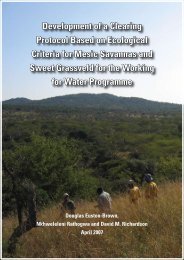Metsi Consultants - DWA Home Page
Metsi Consultants - DWA Home Page
Metsi Consultants - DWA Home Page
You also want an ePaper? Increase the reach of your titles
YUMPU automatically turns print PDFs into web optimized ePapers that Google loves.
METSI CONSULTANTS: SUMMARY OF MAIN FINDINGS FOR PHASE 1 DEVELOPMENT<br />
Table C.1 An example of the information contained in a consequence entry. Sev. = severity rating. % = equivalent<br />
percent reduction or increase in abundance or occurrence. For an explanation of severity rating see<br />
Section 4.2.<br />
Site<br />
Flow<br />
Aspect<br />
IFR 1 Wet-season<br />
low flows<br />
Reduction<br />
Level<br />
Compo<br />
nent<br />
Sub-component Result Sev. % Ecological Comment Social Comment<br />
Level 3 Fish Maluti Minnow Decrease 4 60-80% It is expected that the reduction of the Not commonly<br />
low flow wet period will have a major caught or utilised.<br />
impact on habitat quality and quantity. Red data species<br />
This change to the flow regime would<br />
significantly alter the prediction for this<br />
critically endangered species at this<br />
site, as spawning and migration cues,<br />
and availability and quality of spawning<br />
and incubation habitat would be<br />
reduced. Suitability (habitat criteria) of<br />
lateral habitats for refuge, foraging and<br />
passage of larvae and juveniles would<br />
also be reduced. Consequences<br />
would be evident in the form of<br />
changes in the abundance of larvae<br />
and juveniles and spawning success<br />
and hatching would be compromised.<br />
SOCIO-ECONOMIC COMPONENTS OF THE PROCESS<br />
Identifying the Social Impacts of Biophysical River Changes<br />
Step 17: The extent and nature of use of river resources by riparian people, and the present state of their health<br />
and that of their domestic stock, were described and quantified. The Population At Risk (PAR) was<br />
identified.<br />
Step 18: The predicted reductions in availability of the resources and services under any potential flow regime<br />
(Step 16) were used to rank the social impact for each resource and each health issue.<br />
Calculating the Economic Assessment of Compensation and Mitigation<br />
Step 19: An economic assessment was made of the current value of all river resources and services used by<br />
the PAR, using information from the detailed social survey.<br />
CALCULATING THE IMPACT ON THE SYSTEM YIELD<br />
Step 20: A yield analysis was performed using the volumes calculated in Step 14, to determine the impact of<br />
supplying a given flow regime to the downstream river on the yield.<br />
OUTPUTS OF THE DRIFT PROCESS<br />
The outputs consisted of the predicted consequences of four possible future flow regimes for the study rivers.<br />
These were referred to as IFR scenarios, and consisted of the following information.<br />
A modified flow regime for each part of each affected river. This is expressed in terms of:<br />
− low flows: seasonal upper and lower discharge ranges, and monthly averages for discharge and<br />
volume.<br />
− high flows:magnitude, duration and timing of flood events.<br />
Report No. 678-F-001 C-3

















